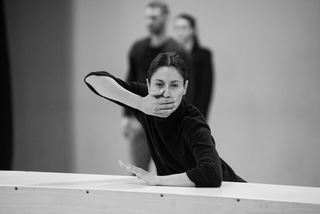Internationally acclaimed immersive theatre company Punchdrunk returns to London with its new show The Drowned Man: A Hollywood Fable. Nicola Rayner speaks to associate director and choreographer, Maxine Doyle.
What can you tell us about The Drowned Man?
It is inspired by Büchner’s Woyzeck, which is a tale of a lonely solider who is driven mad by his circumstances and jealousy and obsession, and who murders his wife… but we’ve taken that text and transposed it to 1960s Hollywood, inside and outside of the studio system, and the poverty and the desperadoes that exist outside of it.
It’s all told through a contemporary dance language, with highly physical, visual, visceral choreography, so there’s no text in the work, as such, and it plays out across four floors of a huge warehouse space [in Paddington].
With Punchdrunk what happens is we transform the building into really rich design-installation environments that reflect the world of the play… we have a cast of 30 who are around the building and the audience are all masked and sent in, in various ways, and then they’re left to roam. So the work is really structured but there’s no predetermined route – the audience choose where they go.
Why does Punchdrunk use dancers rather than actors?
When I started working with Felix [Barrett], the artistic director of Punchdrunk, his challenge to me was to create a Macbeth without words, because he had been working very much in buildings, creating this exciting scenography… We thought it might be really exciting to uncover the mysteries of a building, and that it might be kind of mundane and a little bit easy for the audience if it was just speaking.
So we did the first project together, Sleep No More, and we felt that we’d tapped into something quite exciting. There are six actors in the company who do very particular roles, but otherwise the other 27 are all dancers. They do act, but you couldn’t do this show if you were an actor.
Are you going to use the same masks as you did for Sleep No More?
They’re going to be the same. We’ve worked hard to evolve those over the years to find the right kind of aesthetic and expression and for them to be comfortable… [Felix] conceived the mask as a device to separate the audience from the performer, so the action could stand up and stand out. Over the years it’s really become our theatre seat. It does a similar kind of job. As well as making our audience characters, kind of ghostly characters.
Has anything ever gone strangely or wrong?
Most of the time the audience are really well-behaved. They get the game. They’re curious, but respectful… Sometimes the mask can do strange things to people and the audience can become over-zealous. And obviously sometimes you get idiots.
The mask can give you a confidence – and we want that; we want people to go to the sweet shop and take a sweet or look in a drawer and come close to see if they have that urge. But we also trust that people are respectful. It’s complicated for the audience – we expect them to work out the rules without telling them what they are.
Read the full article at dancing-times.co.uk here



